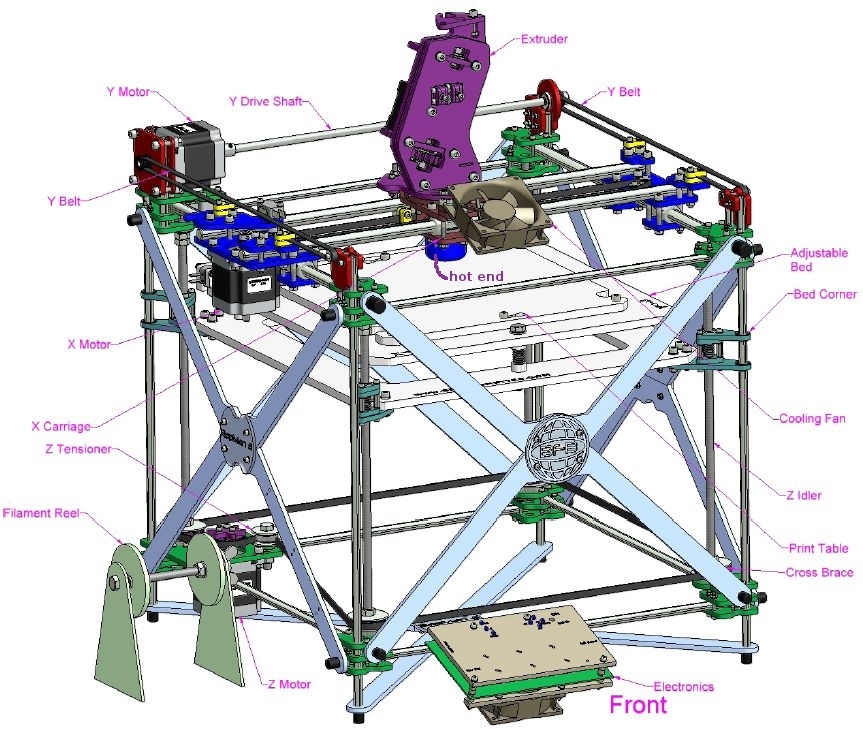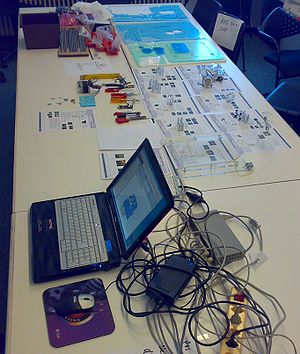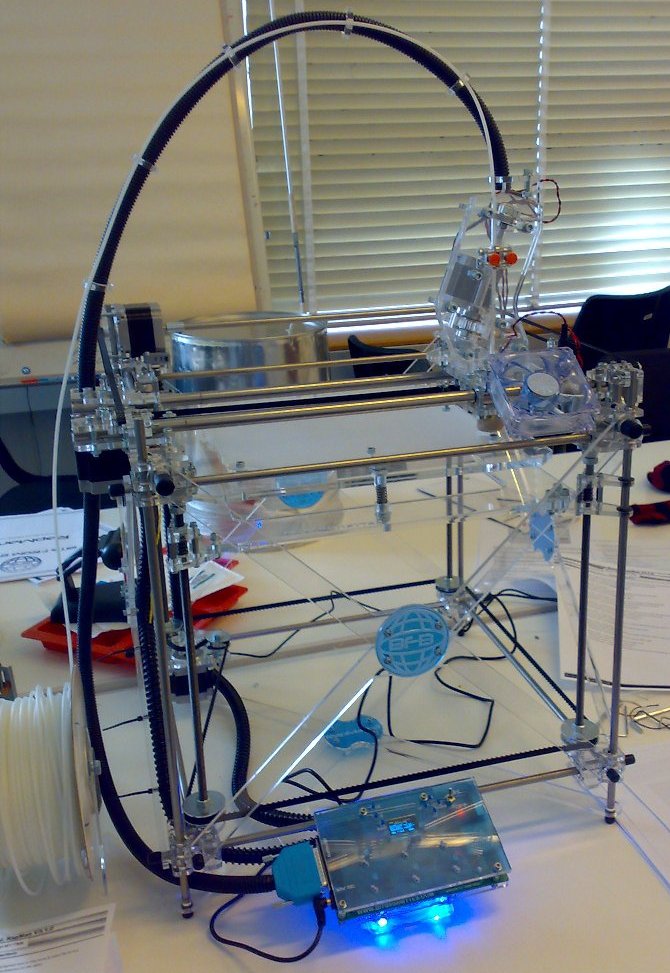RapMan
This article or section is currently under construction
In principle, someone is working on it and there should be a better version in a not so distant future.
If you want to modify this page, please discuss it with the person working on it (see the "history")
Introduction
RapMan is a commercial kit of the RepRap 3D printer. “RepRap is short for Replicating Rapid-prototyper since it was developed in a research project on self-replicating machines.
This 3D printer builds the parts up in layers of plastic with the help of a custom-made Thermoplast Extruder. The machine takes a 3mm diameter filament of a polymer, forces it down a heated barrel, and then extrudes it as a melt out of a fine nozzle. The resulting thin stream is laid down in layers to form the parts that RepRap makes. The extruder should work up to a temperature of 260 degrees Celsius”. It works with various polymers like ABS (Lego-like plastic) and polylactic acid. The extruder can move left/right (X axis) and forward/backward (Y axis) The printed object sits on a platform that will move down (Z axis)
This article has two functions:
- It's a meta manual for Rapman version 3.1: We will try to explain how RapMan works in order to help the reader understanding stages of assembly and we will point out to the most important manuals and other information sources you should read
- We will add some missing points and report some difficulties.
Parts, manuals and workspace
.
When we ordered a Reprap it came in a fairly small plastic-wrapped cardboard box. In addition, we got some boxes with polymer filaments (6 ABS rolls and some others ...). To the left is a picture.
You may check the insides of the boxes. E.g. compare contents to the list that you can find in each of the three following manuals, i.e. in the "included" section in the begging.
- Build manual (for the "cartesian robot")
- Extruder manual
- Hot End manual (pink cables were missing from both the 3.1 version and in our case in the delivered kit)
Finally, there may be faulty pieces. In our case the holes in the base bed (page 51 of the build manual) were not straight. Other folks in the forum reported this problem. IMHO ours were sort of straight enough. The setup, i.e. a bolt with spring that ties down the print bed is used to micro-ajust the level of the print bed in 3 dimensions (see the operations manual).
It's easier to reserve a lot of space for assembly. At TECFA, we used our seminar room and took about 2 x 6 meters :). See picture to the right.
Now, keep the following picture from the build manual in mind. This is what you are going to build. The most important parts are labelled (we added the hot end, i.e. part of the extruder that will heat the plastic filament).

You also should look a real picture, below is ours:
Overview of the manuals
All manuals are available at Bits from Bytes. At the time of writing they could be found in the downloads section. The [ build info] section includes outdated version. So, in any case, always make sure that you get the manuals for the version you ordered, e.g. RapMan 3.1. Here is a list of the manuals:
- Build Manual - Printed: This manual explains how to assemble the so-called cartesian robot. This refers to the printer (including the motors and the belts that will move the extruder in the X/Y axis and the plate up/down (Z-axis). In other words, it's all that's mechanical, except the extruder.
- 3D Build Manual part 1: As above but include 3D models that you can view in PDF. Click on a "picture" to enter 3D mode. Make sure to install the lastet PDF version and to use a PC with a decent graphics card. Also, explore the Acrobat menu to the left. You can add-remove parts for better visibility.
- 3D Build Manual Part 2: As above, part 2. Also includes writing of the motors and the controller.
- Animated Build Manual: As above, but includes animations. We didn't use this manuals
- Build Manual Videos: This manual includes three videos that show how to build some of the more difficult parts.
- Extruder Manual: Explains how to assemble the extruder, i.e. the print head that will be moved around in X/Y directions by the "cartesian robot". It will pull in the plastic filament and feed it into the so-called attached hot end which you somewhere during the assembly process. Finally it also explains how to wire the extruder to the controller.
- Hot End Manual: Explains how to assemble the hot end. The hot end will heat the plastic. It's a bit tricky to assemble since you have to wrap the heating wire around, attache a temperature probe and wrap fire cement around.
- Operations Manual: Explains how to use the printer. In particular calibrate the print head, update the firmware and use the controller interface.
Notice: In some case, the newer version did not have enough information to understand the process. E.g. we looked at some 3.0 version manuals where procedures are explained in more detail. However, this information needed to be adapted, because some parts are not the same and generally speaking 3.1 is easier, in particular assemblying the hot end !
As of Feb 2010, the build manual is quite superb (with little mistakes), the extruder manual is ok enough, since at this stage you can build without reading .... The hot end manual is not good enough (yet).
Tools
Then you will have to buy tools. All except two can be easily found in a do-it-yourself store. Read: V3Info.pdf (this file may not sit next to the build manual). Dictionnary (terms are in UK English):
- A spanner is called Wrench in US English, "clef à écrous" en français
- Allen key is a "hex key" or "hex head wrench"
- A Needle file is a small abrasive file.
Easy to find tools
- 4mm Spanner 1
- 5.5mm Spanner 1
- 8mm Spanner 1
- 13mm Spanner 2
- 1.5mm Ball End Allen Key 1 (it's important to get ball ended keys, since sometimes you will "come in diagonally". We suggest to buy quality tools, because of easier fit).
- 2.5mm Ball End Allen Key 1
- 4mm Ball End Allen Key 1
- 2mm Flat Blade Screw Driver 1
- Tape Measure 1
- Soldering Iron 1
- 1/2 Round Needle File 1 (we actually suggest to buy several ones including a square-shaped one. Since these are used by modeling fans you can get handfull of various shapes for about 5 to 15 Euros (depending on quality). We got the cheap ones.
- Wire Cutters 1 (maybe not needed, since a stripper also can cut)
- Wire Strippers
The difficult ones are:
- A good multimeter that can measure small resistance. We didn't test resistance ... ;)
- A 1/16'' Allen key. We found it w/o problem in a hardwarestore that sells to professionals
Optionally, you also might acquire a key that can measure a small torque presure (the typical thing you get in hardware stores is just good for the nuts on car wheels). This is an expensive profesional tool. We didn't get one. (see practice run)
The assembly procedure
Practice run and parts terminology
The practice run has three important functions:
(1) You will learn how much you can tighten the screws. The golden rule is simple: really ringer tight then add 1/2 turn with a key.
(2) Terminology: Although we do understand English, we didn't know about these:
- A washer is a "flat disk" (rondelle in french)
Also remember to look at the "big picture" on top for terminology of the rapman parts.
(3) Learn how to read the manual
Tuning
Printing
G-code
3d model into G-Code
Skeinforge is a tool chain composed of Python scripts that converts your 3d model into G-Code instructions for Rapman.
- Download: Skeinforge
- Read Skeinforge
In education
See Teaching Resources (BitsforBytes Wiki)
Links
Research Reprap 3D printer
- RepRap, a British project, is short for Replicating Rapid-prototyper. This 3D printer builds the parts up in layers of plastics. It can be assembled from parts bought in various places.
- RepRap Project (Wikipedia)
- Introduction to Reprap, retrieved 24 June 2009.
- RepRap Official Blog
- Spare parts: See reprapsource. German company that sells spare parts.
BitsfromBytes RepRap
- Bits from Bytes. Sells RepRap kits (£750 / CHF 1270).
- This web site also includes a forum an a wiki.



